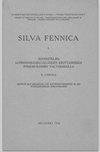Utilization potential of naturally regenerated Mongolian Betula platyphylla wood based on growth characteristics and wood properties
IF 1.7
3区 农林科学
Q2 FORESTRY
引用次数: 9
Abstract
To preliminary evaluate the potential wood utilization of Betula platyphylla Sukaczev trees naturally regenerated in Mongolia, growth characteristics (stem diameter and tree height), wood properties (annual ring width, basic density, and compressive strength parallel to grain at the green condition) of core samples, and stress-wave velocity in stems were investigated for Betula platyphylla trees grown naturally in three different sites in Selenge, Mongolia. Betula platyphylla trees, naturally grown in Nikko, Japan, were also examined to compare wood properties between the two regions. The mean values of stem diameter, tree height, stress-wave velocity of stems, annual ring width, basic density, and compressive strength parallel to grain at green condition in Mongolian B. platyphylla were 17.6 cm, 14.1 m, 3.50 km s–1, 1.27 mm, 0.51 g cm–3, and 20.4 MPa, respectively. Basic density and compressive strength were decreased first from the pith, and then gradually increased toward the bark. The wood properties of B. platyphylla trees grown naturally in Mongolia were similar to those in B. platyphylla trees grown in Japan. Growth characteristics, especially stem diameter, were positively correlated with the stress-wave velocity of stems and basic density. Early evaluation of basic density in B. platyphylla trees is possible by using wood located 2 cm from the pith. Basic density at the position from the 1st to the 15th annual ring from the pith showed significant between-site differences in Mongolian B. platyphylla. Based on the results, it is concluded that the wood of B. platyphylla trees grown in Mongolia may be used for industrial products as well as those from similar species in other countries.基于生长特性和木材特性的自然再生蒙古白桦木材利用潜力研究
为初步评价蒙古自然再生白桦(Sukaczev)木材利用潜力,对蒙古色楞格3个不同样地自然生长的白桦(Betula platyphylla Sukaczev)的生长特征(茎粗、树高)、木材特性(年轮宽度、基本密度、绿色条件下平行于颗粒的抗压强度)和树干应力波速度进行了研究。自然生长在日本日光的白桦也被用来比较两个地区的木材特性。绿色条件下,白杨茎粗、树高、茎应力波速度、年轮宽度、基本密度和平行于粒的抗压强度平均值分别为17.6 cm、14.1 m、3.50 km s-1、1.27 mm、0.51 g cm - 3和20.4 MPa。基本密度和抗压强度先从髓部开始减小,然后逐渐向树皮方向增大。蒙古自然生长的白桦的木材特性与日本生长的白桦相似。生长特性,尤其是茎粗与茎的应力波速度和基本密度呈正相关。利用距叶髓2cm处的木材,可以对白桦树的基本密度进行早期评价。白桦第1 ~ 15年轮位置的基本密度在不同地点间存在显著差异。综上所述,蒙古的白桦木材可用于工业生产,其他国家的白桦木材也可用于工业生产。
本文章由计算机程序翻译,如有差异,请以英文原文为准。
求助全文
约1分钟内获得全文
求助全文
来源期刊

Silva Fennica
农林科学-林学
CiteScore
3.50
自引率
11.10%
发文量
21
审稿时长
3 months
期刊介绍:
Silva Fennica publishes significant new knowledge on forest sciences. The scope covers research on forestry and forest ecosystems. Silva Fennica aims to increase understanding on forest ecosystems, and sustainable use and conservation of forest resources. Use of forest resources includes all aspects of forestry containing biomass-based and non-timber products, economic and social factors etc.
 求助内容:
求助内容: 应助结果提醒方式:
应助结果提醒方式:


